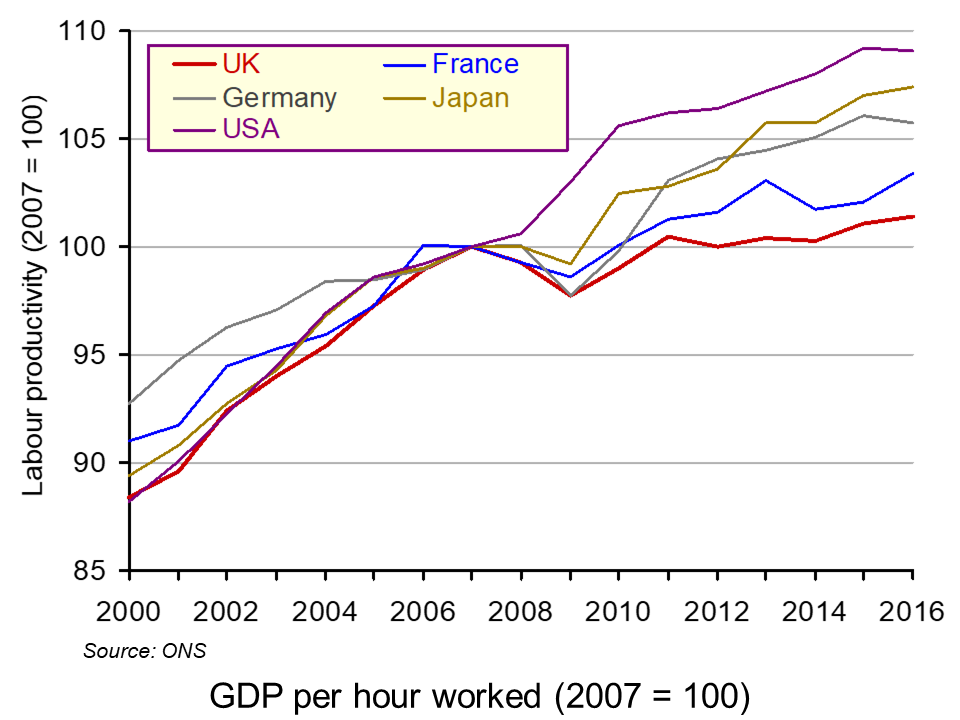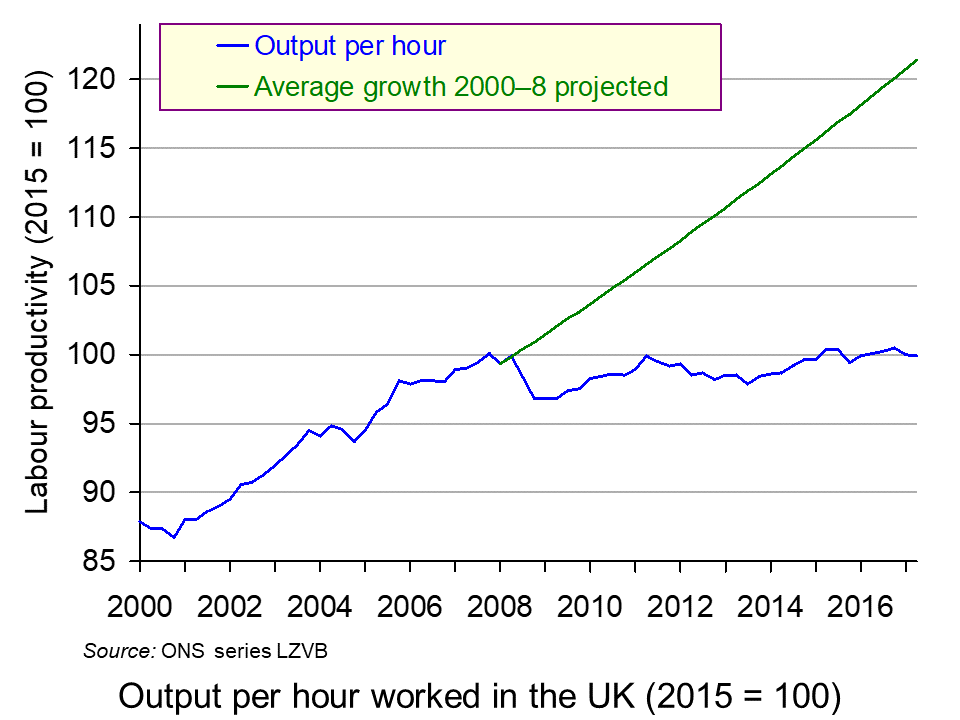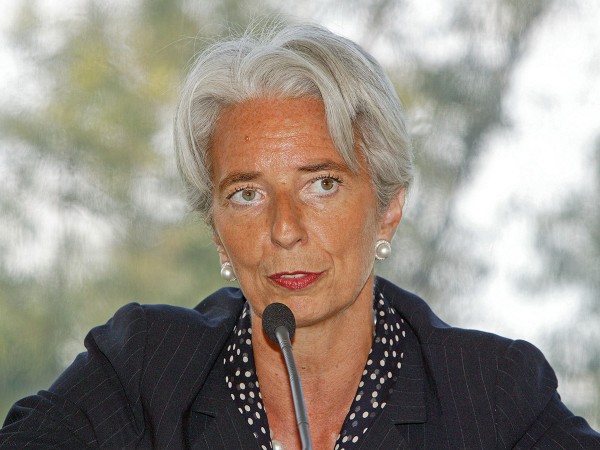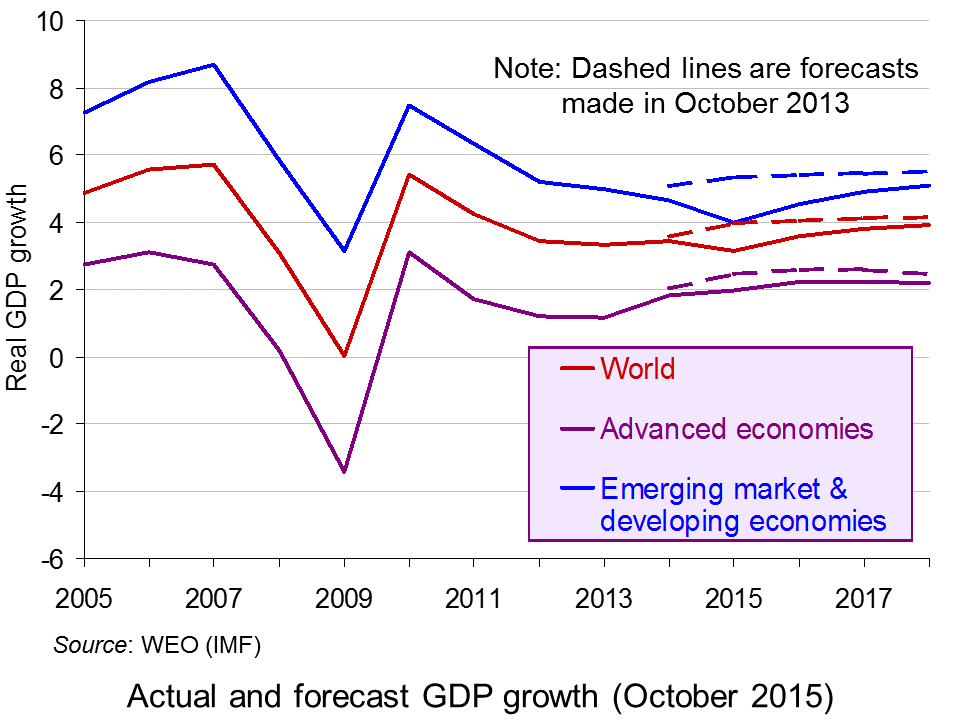 In various blogs, we’ve looked at the UK’s low productivity growth, both relative to other countries and relative to the pre-1998 financial crisis (see, for example, The UK productivity puzzle and Productivity should we be optimistic?). Productivity is what drives long-term economic growth as it determines potential GDP. If long-term growth is seen as desirable, then a fall in productivity represents a serious economic problem.
In various blogs, we’ve looked at the UK’s low productivity growth, both relative to other countries and relative to the pre-1998 financial crisis (see, for example, The UK productivity puzzle and Productivity should we be optimistic?). Productivity is what drives long-term economic growth as it determines potential GDP. If long-term growth is seen as desirable, then a fall in productivity represents a serious economic problem.
Recent data suggest that the problem, if anything, is worse than previously thought and does not seem to be getting better. Productivity is now some 21% below what it would have been had productivity growth continued at the rate experienced in the years before the financial crisis (see second chart below).
In its latest productivity statistics, the ONS reports that labour productivity (in terms of output per hour worked) fell by 0.1% in the second quarter of 2017. This follows a fall of 0.5% in quarter 1. Over the whole year to 2017 Q2, productivity fell by 0.3%.
 Most other major developed countries have much higher productivity than the UK. In 2016, Italy’s productivity was 9.9% higher than the UK’s; the USA’s was 27.9%, France’s was 28.7% and Germany’s was 34.5% higher. What is more, their productivity has grown faster (see chart).
Most other major developed countries have much higher productivity than the UK. In 2016, Italy’s productivity was 9.9% higher than the UK’s; the USA’s was 27.9%, France’s was 28.7% and Germany’s was 34.5% higher. What is more, their productivity has grown faster (see chart).
But what of the future? The Office for Budget responsibility publishes forecasts for productivity growth, but has consistently overestimated it. After predicting several times in the past that UK productivity growth would rise towards its pre-financial crisis trend of around 2% per year, in its October 2017 Forecast evaluation Report it recognises that this was too optimisitic and revises downwards its forecasts for productivity growth for 2017 and beyond.
As the period of historically weak productivity growth lengthens, it seems less plausible to assume that potential and actual productivity growth will recover over the medium term to the extent assumed in our most recent forecasts. Over the past five years, growth in output per hour has averaged 0.2 per cent. This looks set to be a better guide to productivity growth in 2017 than our March forecast of 1.6 per cent.
Looking further ahead, it no longer seems central to assume that productivity growth will recover to the 1.8 per cent we assumed in March 2017 within five years.
 But why has productivity growth not returned to pre-crisis levels? There are five possible explanations.
But why has productivity growth not returned to pre-crisis levels? There are five possible explanations.
The first is that there has been labour hoarding. But with companies hiring more workers, this is unlikely still to be true for most employers.
The second is that very low interest rates have allowed some low-productivity companies to survive, which might otherwise have been driven out of business.
The third is a reluctance of banks to lend for investment. After the financial crisis this was driven by the need for them to repair their balance sheets. Today, it may simply be greater risk aversion than before the financial crisis, especially with the uncertainties surrounding Brexit.
The fourth is a fall in firms’ desire to invest. Although investment has recovered somewhat from the years directly following the financial crisis, it is still lower than might be expected in an economy that is no longer is recession. Indeed, there has been a much slower investment recovery than occurred after previous recessions.
The fifth is greater flexibility in the labour market, which has subdued wages and has allowed firms to respond to higher demand by taking on more relatively low-productivity workers rather than having to invest in human capital or technology.
Whatever the explanation, the solution is for more investment in both technology and in physical and human capital, whether by the private or the public sector. The question is how to stimulate such investment.
Articles
UK productivity lagging well behind G7 peers – ONS Financial Times, Katie Martin (6/10/17)
UK productivity sees further fall BBC News (6/10/17)
UK resigned to endless productivity gloom The Telegraph, Tim Wallace (10/10/17)
UK productivity estimates must be ‘significantly’ lowered, admits OBR The Guardian, Richard Partington and Phillip Inman (10/10/17)
UK productivity growth to remain sluggish, says OBR BBC News (10/10/17)
Official Treasury forecaster slashes UK productivity growth forecast, signalling hole in public finances for November Budget Independent, Ben Chu (10/10/17)
The Guardian view on Britain’s productive forces: they are not working The Guardian, Editorial (10/10/17)
Mind the productivity gap: the story behind sluggish earnings The Telegraph, Anna Isaac (26/10/17)
Data and statistical analysis
Labour productivity: April to June 2017 ONS Statistical Bulletin (6/10/17)
International comparisons of productivity ONS Dataset (6/10/17)
Forecast evaluation report OBR (October 2017)
Questions
- Explain the relationship between labour productivity and potential GDP.
- What is the relationship between actual growth in GDP and labour productivity?
- Why does the UK lag France and Germany more in output per hour than in output per worker, but the USA more in output per worker than in output per hour?
- Is there anything about the UK system of financing investment that results in lower investment than in other developed countries?
- Why are firms reluctant to invest?
- In what ways could public investment increase productivity?
- What measures would you recommend to encourage greater investment and why?
- How do expectations affect the growth in labour productivity?
 According to Christine Lagarde, Managing Director of the IMF, the slow growth in global productivity is acting as a brake on the growth in potential income and is thus holding back the growth in living standards. In a recent speech in Washington she said that:
According to Christine Lagarde, Managing Director of the IMF, the slow growth in global productivity is acting as a brake on the growth in potential income and is thus holding back the growth in living standards. In a recent speech in Washington she said that:
Over the past decade, there have been sharp slowdowns in measured output per worker and total factor productivity – which can be seen as a measure of innovation. In advanced economies, for example, productivity growth has dropped to 0.3 per cent, down from a pre-crisis average of about 1 per cent. This trend has also affected many emerging and developing countries, including China.
We estimate that, if total factor productivity growth had followed its pre-crisis trend, overall GDP in advanced economies would be about 5 percent higher today. That would be the equivalent of adding another Japan – and more – to the global economy.
So why has productivity growth slowed to well below pre-crisis rates? One reason is an ageing working population, with older workers acquiring new skills less quickly. A second is the slowdown in world trade and, with it, the competitive pressure for firms to invest in the latest technologies.
 A third is the continuing effect of the financial crisis, with many highly indebted firms forced to make deep cuts in investment and many others being cautious about innovating. The crisis has dampened risk taking – a key component of innovation.
A third is the continuing effect of the financial crisis, with many highly indebted firms forced to make deep cuts in investment and many others being cautious about innovating. The crisis has dampened risk taking – a key component of innovation.
What is clear, said Lagarde, is that more innovation is needed to restore productivity growth. But markets alone cannot achieve this, as the benefits of invention and innovation are, to some extent, public goods. They have considerable positive externalities.
She thus called on governments to give high priority to stimulating productivity growth and unleashing entrepreneurial energy. There are several things governments can do. These include market-orientated supply-side policies, such as removing unnecessary barriers to competition, driving forward international free trade and cutting red tape. They also include direct intervention through greater investment in  education and training, infrastructure and public-sector R&D. They also include giving subsidies and/or tax relief for private-sector R&D.
education and training, infrastructure and public-sector R&D. They also include giving subsidies and/or tax relief for private-sector R&D.
Banks too have a role in chanelling finance away from low-productivity firms and towards ‘young and vibrant companies’.
It is important to recognise, she concluded, that innovation and structural change can lead to some people losing out, with job losses, low wages and social deprivation. Support should be given to such people through better education, retraining and employment incentives.
Articles
IMF chief warns slowing productivity risks living standards drop Reuters, David Lawder (3/4/17)
Global productivity slowdown risks social turmoil, IMF warns Financial Times, Shawn Donnan (3/4/17)
Global productivity slowdown risks creating instability, warns IMF The Guardian, Katie Allen (3/4/17)
The Guardian view on productivity: Britain must solve the puzzle The Guardian (9/4/17)
Speech
Reinvigorating Productivity Growth IMF Speeches, Christine Lagarde, Managing Director, IMF(3/4/17)
Paper
Gone with the Headwinds: Global Productivity IMF Staff Discussion Note, Gustavo Adler, Romain Duval, Davide Furceri, Sinem Kiliç Çelik, Ksenia Koloskova and Marcos Poplawski-Ribeiro (April 2017)
Questions
- What is the relationship between actual and potential economic growth?
- Distinguish between labour productivity and total factor productivity.
- Why has total factor productivity growth been considerably slower since the financial crisis than before?
- Is sustained productivity growth (a) a necessary and/or (b) a sufficient condition for a sustained growth in living standards?
- Give some examples of technological developments that could feed through into significant growth in productivity.
- What is the relationship between immigration and productivity growth?
- What policies would you advocate for increasing productivity? Explain why.
 In the blog post, Global warning, we looked at the use of unconventional macroeconomic policies to deal with the slow pace of economic growth around the world. One of the articles was by Nouriel Roubini. In the linked article below, he argues that slow economic growth may be the new global norm.
In the blog post, Global warning, we looked at the use of unconventional macroeconomic policies to deal with the slow pace of economic growth around the world. One of the articles was by Nouriel Roubini. In the linked article below, he argues that slow economic growth may be the new global norm.
At the centre of the problem is a fall in the rate of potential economic growth. This has been caused by a lack of investment, which has slowed the pace of innovation and the growth in labour productivity.
The lack of investment, in turn, has been caused by a lack of spending by both households and governments. What is the point in investing in new capacity, argue firms, if they already have spare capacity?
Low consumer spending is partly the result of a redistribution of income from low- and middle-income households (who have a high marginal propensity to consume) to high-income households and corporations (who have a low mpc). Low spending is also the result of both consumers and governments attempting to reduce their levels of debt by cutting back spending.
Low growth leads to hysteresis – the process whereby low actual growth leads to low potential growth. The reason is that the unemployed become deskilled and the lack of investment by firms reduces the innovation that is necessary to embed new technologies.
Read Roubini’s analysis and consider the policy implications.
Article
Has the global economic growth malaise become the ‘new normal’? The Guardian, Nouriel Roubini (2/5/16)
Questions
- Explain what is meant by ‘hysteresis’ and how the concept is relevant in explaining low global economic growth.
- Why has there been a reduction in the marginal propensity to consume in recent years? What is the implication of this for the multiplier and economic recovery?
- Explain what Roubini means by ‘a painful de-leveraging process’. What are the implications of this process?
- How important are structural reforms and what forms could these take? Why has there been a reluctance for governments to institute such reforms?
- ‘Asymmetric adjustment between debtor and creditor economies has also undermined growth.’ Explain what Roubini means by this.
- Why are governments reluctant to use fiscal policy to boost both actual and potential economic growth?
- What feasible policy measures could be taken to boost actual and potential economic growth?
 The International Monetary Fund has just published its six-monthly World Economic Outlook (WEO). The publication assesses the state of the global economy and forecasts economic growth and other indicators over the next few years. So what is this latest edition predicting?
The International Monetary Fund has just published its six-monthly World Economic Outlook (WEO). The publication assesses the state of the global economy and forecasts economic growth and other indicators over the next few years. So what is this latest edition predicting?
Well, once again the IMF had to adjust its global economic growth forecasts down from those made six months ago, which in turn were lower than those made a year ago. As Larry Elliott comments in the Guardian article linked below:
Every year, economists at the fund predict that recovery is about to move up a gear, and every year they are disappointed. The IMF has over-estimated global growth by one percentage point a year on average for the past four years.
In this latest edition, the IMF is predicting that growth in 2015 will be slightly higher in developed countries than in 2014 (2.0% compared with 1.8%), but will continue to slow for the fifth year in emerging market and developing countries (4.0% in 2015 compared with 4.6% in 2014 and 7.5% in 2010).
In an environment of declining commodity prices, reduced capital flows to emerging markets and pressure on their currencies, and increasing financial market volatility, downside risks to the outlook have risen, particularly for emerging market and developing economies.
So what is the cause of this sluggish growth in developed countries and lower growth in developing countries? Is lower long-term growth the new norm? Or is this a cyclical effect – albeit protracted – with the world economy set to resume its pre-financial-crisis growth rates eventually?
 To achieve faster economic growth in the longer term, potential national output must grow more rapidly. This can be achieved by a combination of more rapid technological progress and higher investment in both physical and human capital. But in the short term, aggregate demand must expand sufficiently rapidly. Higher short-term growth will encourage higher investment, which in turn will encourage faster growth in potential national output.
To achieve faster economic growth in the longer term, potential national output must grow more rapidly. This can be achieved by a combination of more rapid technological progress and higher investment in both physical and human capital. But in the short term, aggregate demand must expand sufficiently rapidly. Higher short-term growth will encourage higher investment, which in turn will encourage faster growth in potential national output.
But aggregate demand remains subdued. Many countries are battling to cut budget deficits, and lending to the private sector is being constrained by banks still seeking to repair their balance sheets. Slowing growth in China and other emerging economies is dampening demand for raw materials and this is impacting on primary exporting countries, which are faced with lower exports and lower commodity prices.
Quantitative easing and rock bottom interest rates have helped somewhat to offset these adverse effects on aggregate demand, but as the USA and UK come closer to raising interest rates, so this could dampen global demand further and cause capital to flow from developing countries to the USA in search of higher interest rates. This will put downward pressure on developing countries’ exchange rates, which, while making their exports more competitive, will make it harder for them to finance dollar-denominated debt.
As we have seen, long-term growth depends on growth in potential output, but productivity growth has been slower since the financial crisis. As the Foreword to the report states:
The ongoing experience of slow productivity growth suggests that long-run potential output growth may have fallen broadly across economies.  Persistently low investment helps explain limited labour productivity and wage gains, although the joint productivity of all factors of production, not just labour, has also been slow. Low aggregate demand is one factor that discourages investment, as the last World Economic Outlook report showed. Slow expected potential growth itself dampens aggregate demand, further limiting investment, in a vicious circle.
Persistently low investment helps explain limited labour productivity and wage gains, although the joint productivity of all factors of production, not just labour, has also been slow. Low aggregate demand is one factor that discourages investment, as the last World Economic Outlook report showed. Slow expected potential growth itself dampens aggregate demand, further limiting investment, in a vicious circle.
But is this lower growth in potential output entirely the result of lower demand? And will the effect be permanent? Is it a form of hysteresis, with the effect persisting even when the initial causes have disappeared? Or will advances in technology, especially in the fields of robotics, nanotechnology and bioengineering, allow potential growth to resume once confidence returns?
Which brings us back to the short and medium terms. What can be done by governments to stimulate sustained recovery? The IMF proposes a focus on productive infrastructure investment, which will increase both aggregate demand and aggregate supply, and also structural reforms. At the same time, loose monetary policy should continue for some time – certainly as long as the current era of falling commodity prices, low inflation and sluggish growth in demand persists.
Articles
Uncertainty, Complex Forces Weigh on Global Growth IMF Survey Magazine (6/10/15)
A worried IMF is starting to scratch its head The Guardian, Larry Elliott (6/10/15)
Storm clouds gather over global economy as world struggles to shake off crisis The Telegraph, Szu Ping Chan (6/10/15)
Five charts that explain what’s going on in a miserable global economy right now The Telegraph, Mehreen Khan (6/10/15)
IMF warns on worst global growth since financial crisis Financial Times, Chris Giles (6/10/15)
Global economic slowdown in six steps Financial Times, Chris Giles (6/10/15)
IMF Downgrades Global Economic Outlook Again Wall Street Journal, Ian Talley (6/10/15)
WEO publications
World Economic Outlook, October 2015: Adjusting to Lower Commodity Prices IMF (6/10/15)
 Global Growth Slows Further, IMF’s latest World Economic Outlook IMF Podcast, Maurice Obstfeld (6/10/15)
Global Growth Slows Further, IMF’s latest World Economic Outlook IMF Podcast, Maurice Obstfeld (6/10/15)
Transcript of the World Economic Outlook Press Conference IMF (6/10/15)
World Economic Outlook Database IMF (October 2015 edition)
Questions
- Look at the forecasts made in the WEO October editions of 2007, 2010 and 2012 for economic growth two years ahead and compare them with the actual growth experienced. How do you explain the differences?
- Why is forecasting even two years ahead fraught with difficulties?
- What factors would cause a rise in (a) potential output; (b) potential growth?
- What is the relationship between actual and potential economic growth?
- Explain what is meant by hysteresis. Why may recessions have a permanent negative effect, not only on trend productivity levels, but on trend productivity growth?
- What are the current downside risks to the global economy?
- Why have commodity prices fallen? Who gains and who loses from lower commodity prices? Does it matter if falling commodity prices in commodity importing countries result in negative inflation?
- To what extent can exchange rate depreciation help commodity exporting countries?
- What is meant by the output gap? How have IMF estimates of the size of the output gap changed and what is the implication of this for actual and potential economic growth?
 In the second part of this blog, we look at an interview with the Guardian given by Robert Chote, Chair of the UK’s Office of Budget Responsibility. Like Mervyn King’s, that we looked at in Part 1, Robert Chote’s predictions are also gloomy.
In the second part of this blog, we look at an interview with the Guardian given by Robert Chote, Chair of the UK’s Office of Budget Responsibility. Like Mervyn King’s, that we looked at in Part 1, Robert Chote’s predictions are also gloomy.
In particular, he argues that if Greece leaves the euro, the effects on the UK economy could be significant, not just in the short term, but in the long term too.
The concern is that you end up with an outcome in the eurozone that creates the same sort of structural difficulties in the financial system and in the economy that we saw in the past recession, and that that has consequences both for hitting economic activity in the economy, but also its underlying potential. And it’s the latter which has particular difficulties for the fiscal position, because it means not just that the economy weakens and then strengthens again – ie, it goes into a hole and comes out – but that you go down and you never quite get back up to where you started. And that has more lingering, long-term consequences for the public finances.
The interview looked not just at the effects of the current crisis in the eurozone on the eurozone, British and world economies, but also at a number of other issues, including: the reliability of forecasts and those of the OBR in particular; relations between the OBR and the Treasury; allowing the OBR to cost opposition policies; the economic effect of cutting the 50p top rate of income tax; the sustainability of public-sector pensions; and tax increases or spending cuts in the long term.
In Part 3 we look at attempts by the G8 countries to find a solution to the mounting crisis.
Articles
Robert Chote interview: ‘I would not say in the past there’s been rigging’ Guardian, Andrew Sparrow (18/5/12)
UK ‘may never fully recover’ if Greece exits euro Guardian, Andrew Sparrow, Helena Smith and Larry Elliott (18/5/12)
British economy may ‘never quite recover’ from a severe Euro collapse The Telegraph, Rowena Mason (18/5/12)
OBR report
Economic and fiscal outlook Office for Budget Responsibility (March 2012)
Questions
- Why is it very difficult to forecast the effects of a Greek withdrawal from the euro?
- Why may Greek withdrawal have an effect on long-term potential output in the UK and the rest of Europe?
- Why are economic forecasts in general so unreliable? Does this mean that we should abandon economic forecasting?
- Why are public finances “likely to come under pressure over the longer term”?
- Why might the cut in the top rate of income tax from 50% to 45% have little impact on economic growth? Distinguish between income and substitution effects of the tax cut.
 In various blogs, we’ve looked at the UK’s low productivity growth, both relative to other countries and relative to the pre-1998 financial crisis (see, for example, The UK productivity puzzle and Productivity should we be optimistic?). Productivity is what drives long-term economic growth as it determines potential GDP. If long-term growth is seen as desirable, then a fall in productivity represents a serious economic problem.
In various blogs, we’ve looked at the UK’s low productivity growth, both relative to other countries and relative to the pre-1998 financial crisis (see, for example, The UK productivity puzzle and Productivity should we be optimistic?). Productivity is what drives long-term economic growth as it determines potential GDP. If long-term growth is seen as desirable, then a fall in productivity represents a serious economic problem. Most other major developed countries have much higher productivity than the UK. In 2016, Italy’s productivity was 9.9% higher than the UK’s; the USA’s was 27.9%, France’s was 28.7% and Germany’s was 34.5% higher. What is more, their productivity has grown faster (see chart).
Most other major developed countries have much higher productivity than the UK. In 2016, Italy’s productivity was 9.9% higher than the UK’s; the USA’s was 27.9%, France’s was 28.7% and Germany’s was 34.5% higher. What is more, their productivity has grown faster (see chart). But why has productivity growth not returned to pre-crisis levels? There are five possible explanations.
But why has productivity growth not returned to pre-crisis levels? There are five possible explanations.







